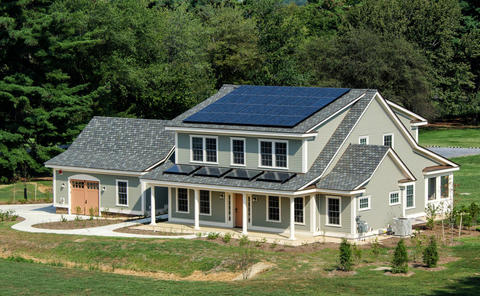
We are what we build, and historically, what we’ve built is often composed of toxic garbage. In all fairness, this wasn’t a conscious choice because, historically, matters related to VOCs and related chemicals in our building materials simply weren’t of concern, if understood at all. We clear cut; we baked, mixed, and poured with abandon; we emitted toxins and permitted runoff into our waterways all in the name of progress. Fortunately, that tide is shifting, and not a moment too soon.
A new book from Ecotone, the publishing arm of the International Living Future Institute (ILFI), entitled The Regenerative Materials Movement, compiles a series of “dispatches” from more than two dozen thought leaders and changemakers working in the interrelated fields of material ecology and chemistry, regenerative design, and circular economies. For anyone interested in learning about what is actively being done—through the lens of building materials—to create built environments that are restorative and equitable, this is an invaluable compendium.
“We are beginning to know what we are building our buildings with, certainly enough to understand and make better decisions about the impacts we want them to have,” reads an excerpt from the introduction, written by ILFI CEO Lindsay Baker. ” . . . the movement is moving fast,” she continues. “We have no delusions that this book will feel up-to-date and thorough even five years from now.”
The book, edited by Juliet Grable, is broken up into three parts: Justice & Equity, Health, and Climate & Environment. This sequencing helps paint a holistic picture of what constitutes “regenerative” materials, as in, they not only contribute to healthy buildings and people, but healthier ecosystems, labor practices, job markets, and supply chains.
Recently, I had the pleasure of speaking with three of the book’s contributors (one per section), who shared with me their ongoing advocacy work and how it applies to the materials movement. If there is a common thread across their respective dispatches, it’s that when it comes to ensuring regenerative materials in our built environment, we must look to the source.
Justice & Equity
Sharon Prince (“Embodied Suffering in Our Building Materials”) is CEO and founder of Grace Farms Foundation, in New Canaan, CT. In 2020, Grace Farms launched Design for Freedom, a movement that is working to eliminate forced labor from the materials supply chain. Prince is an outspoken proponent for “architectural justice,” and believes that materials cannot be considered truly regenerative or part of a circular economy until the global building industry no longer accepts the “slavery discount” on such ubiquitous raw and composite materials like steel, glass, bricks, stone, copper, textiles, and timber. (We can also add solar panels to the list.) In her chapter she writes, “The largest industrialized sector with the highest risk of modern slavery is getting a labor transparency pass. It is stunning that today there is no ethical labor inspection of the building materials supply chain, which accounts for roughly 50 percent of the building’s cost.”
A kneejerk response to this problem might be to say, Well, let’s just stop importing from countries where modern slavery is prevalent. This would be noble, but naïve, especially when considering that among the ten nations with the highest number of people living in modern slavery (heads up: the U.S. is on that list), six are in the G20, and collectively, G20 countries import $468 billion of at-risk products annually, according to Walk Free. Design for Freedom’s objective is to “normalize fair labor input” to the point where top corporations codify these standards into their practices, and shift market forces as a result.
Prince points out that an ethical procurement process is already largely baked into the system, thanks to the green building movement and growing concerns over embodied carbon. The means and methods of tracing carbon is slowly being adopted by the industry. However, the country of origin and “fair labor inputs have been left out,” she says. In calculating the slavery discount, Prince doesn’t mince words when equating lower material costs with increased human suffering. Without inspection, there is an inverse relationship between driving down costs and the risk of raising the human cost. Low material costs and profit margins may flow not from innovation, she says, but from exploitation.
As far as the green building movement has come in recent decades, Prince highlights a glaring omission. We can qualify and quantify a building’s sustainable performance, but when it comes to addressing whether it’s the product of ethical procurement and is “forced-labor free,” we simply don’t know. “This is not an opt-in movement,” she says, “it’s just a question of enforcement.”
Health
Dr. Christina Raab (“A Regenerative Built Environment Starts with Intentional Material Design”) holds a PhD in materials chemistry and is the former CEO of the Cradle to Cradle Products Innovation Institute, headquartered in Amsterdam. Like Prince, Raab connects the idea of circularity with what we put into our buildings, but more so, what happens to all those building blocks after the fact. A building and its myriad components cannot be called regenerative unless the entire project is “designed for regenerative outcomes,” Raab says.
“Nature, by default, is regenerative,” Raab writes. “In practice, regenerative design requires applying integrated thinking and considering the linkages between design, production, use and end-of-use of materials.”
Admittedly, instituting absolute transparency throughout the global supply chain, in terms of material health, is a monumental undertaking, with too many moving parts to count. This isn’t lost on Raab, but she remains optimistic and unphased by the challenge. In her view, achieving transparency (and, consequently, a functioning circular economy) requires systems thinking and applying that to both sides of the materials spectrum: those who manufacture the products and those who design them into buildings. In such an arrangement, manufacturers hold suppliers of raw materials accountable, and designers hold manufacturers accountable by ensuring other stakeholders (owners, occupants, the public at large) that information regarding a building’s ingredients is fully accessible.
But what form does that accessibility take? Raab endorses the idea of a “material passport” for building components—basically akin to transparency labels like Cradle to Cradle, Declare, or EPDs, only more robust. With a composite of passports, one can form a comprehensive picture of a building’s ingredients and yield a digital copy of that building. This can also act as a kind of road map for recycling, reusing, or repairing parts or all of the building, “because that material bank tells you exactly what’s in there,” Raab says.
This isn’t theoretical either. As Raab points out, digital product passports will soon become mandatory throughout the EU. And scaling up that kind of material transparency will inevitably bring the building industry closer to where it needs to be, namely, beyond mere sustainability and into the realm of regeneration.
Climate & Environment
Kathleen Hetrick (“Think Supply Chain First: Supply Chains Are the Key to Social Equity, Human Health and Climate Goals”) is an engineer with Buro Happold and a Bloomberg MPH Fellow at Johns Hopkins Bloomberg School of Public Health. Hetrick embodies systems thinking. Her cautiously optimistic world view—which is shaped around buildings, for obvious reasons—is one of intersecting manufacturing processes and supply chains, and their outcomes. The crux of Hetrick’s dispatch goes beyond questions of sustainability or even ethical procurement. “We cannot limit our standards for health and carbon impact to just building materials and their supply chains,” she writes. “If we care about human and environmental health . . . we must extend Red List-free criteria to our consumer care products, data centers, durables, food systems, and everything in between.”
The health impacts of our material choices are quantifiable and palpable. And this is particularly acute, Hetrick observes, in environmental justice communities found in the Ohio River Valley and Louisiana’s “Cancer Alley,” among others, where the upstream impacts from dirty manufacturing are largely ignored, at least by the design and building community. “We’re all thinking about embodied carbon,” she says. “But we’re not thinking about how reliant we are on the oil industry for so much of our products that fly under the radar.
“Don’t just slap some solar on your building,” she continues. “Let’s actually design the bad stuff out, and the building industry is a [big part] of why we still rely on petrochemicals” to make our products.
Getting the “bad stuff out” is really a question of good stewardship, and good stewards, as we all know, don’t materialize out of thin air. People need convincing, often with a stick as opposed to a carrot. To that end, Hetrick believes that the ‘S’ in ESG (environmental, social, and governance) practices can become just as quantifiable as the ‘E’. In other words, if businesses willfully ignore environmental justice issues, they put their social license to operate at grave risk. Still, what does that look like in terms of hard numbers? Hetrick sees the answer in capital improvement plans.
“Capital planning is how you get that stuff done. If you have these multi-million-dollar budgets approved by your company to do ESG work, you can change supply chains just by thinking about your buildings a lot better.”
Choices matter
If there is one takeaway from reading “The Regenerative Materials Movement,” it’s that our material choices are not limited to a single conversation, whether that’s scope 3 emissions, embodied carbon, Red List materials, or otherwise. There is a universe of considerations that building professionals are being asked to account for today, well beyond any standards our predecessors were held to, and there’s no indication that the needle will reverse course. And clearly, when faced with the prevalence of ESG policies and regulations, it rubs some players the wrong way. Practically speaking, the choices we make should be designed to help the industry absorb the added costs associated with more stringent vetting processes and the like. To get there, we need to normalize systems thinking. And we will need everyone on board.
“These are not ordinary, daily choices that most people make,” Lindsay Baker writes in the introduction. “The thing that makes the act of building so distinct and so important is that each choice we make has lasting impacts far beyond the moment and place in which we make it.”
If ever our society can achieve anything resembling a green economy, it’s a safe bet that Sharon Prince, Christina Raab, Kathleen Hetrick, and many of their fellow contributors will be among those at the vanguard, holding key players accountable for their choices.
________________________________________________________________________
Justin R. Wolf is a Maine-based writer who covers green building trends and energy policy.
Weekly Newsletter
Get building science and energy efficiency advice, plus special offers, in your inbox.















One Comment
Step one, maximize the use of local resources.
Most lumber, concrete, reinforcing steel, glass and window frame materials, as well as the several asphalt shingle roofing manufacturers I looked into all have their primary manufacturing facilities in North America. I haven't looked into finish materials as there is such a huge array. Nor have I looked into MEP systems. There are, of course, plenty of North American hardwoods. I would be interested to know what are the primary categories of imported products in new North American houses. Anything electronic is problematic in terms of sourcing, though with new chip manufacturing in the USA hopefully that will get better.
Per the Walk Free Global Slavery Index the top 10 worst nations on a per capita basis are:
North Korea (#1), Eritrea, Mauritania, Saudi Arabia, Turkey, Tajikistan, UAE, Russia, Afghanistan, Kuwait (#10)
Per the same organization the USA falls in position 123 out of the list of 160 countries shown. Canada is in position 143. China (a country whose products I avoid) falls at 108. All of Western Europe does better than the USA and all of Eastern Europe does worse.
Walk Free uses a definition of slavery that includes prison labor, in contradiction with the ILO Forced Labour Convention definition. This is a substantial contribution for the USA figure and moves it several places on the overall country list. The other major factor is the employment of undocumented immigrants, who lack the legal safeguards available to documented immigrants and citizens. The message there seems to be that we should be avoiding the use of undocumented workers on our jobsites and not be buying products from companies that use them, as doing so supports the people who employ them under inadequate conditions.
My point in all this? Comments such as the following -
"among the ten nations with the highest number of people living in modern slavery (heads up: the U.S. is on that list)"
though literally accurate, fail completely to depict an accurate picture either of the situation within the USA or the situation of the USA within the rest of the world. In fact, through omission it paints a false picture. The issue is very, very complex.
Log in or create an account to post a comment.
Sign up Log in